Industry Outlook: Mini-excavators
Electric models, telematics and attachments lead rental center interest.
Mini excavators in rental fleets are increasingly emissions-free models that rely on telematics to broadcast machine health and use. Early adopters are finding these machines are lower in cost to operate and can be used where engine-powered units can’t. Manufacturers share their views on the trends taking place today.
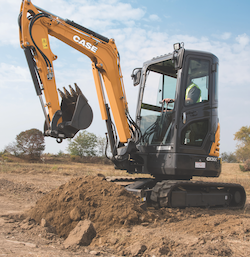 |
| Sharing with equipment companies customers’ needs can help rental centers select the right mini excavator configuration and attachments to assure high utilization rates. |
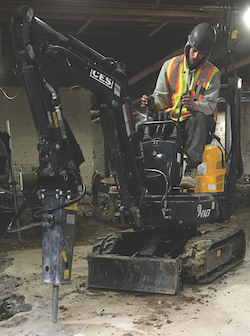 |
| Battery-powered mini excavators are gaining interest because of their emissions-free operation and lower operating cost. |
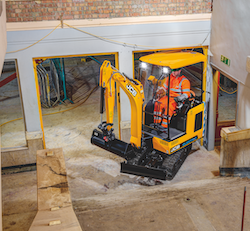 |
|
The 2-ton JCB 19C-1E is ideally suited to excavation applications within enclosed or urban job sites, or noise- and emissions-sensitive environments such as hospitals and schools. JCB research indicates that electric charging costs for the 19C-1E are 50 percent lower than fuel costs for a comparable diesel powered machine over a five-year ownership period. |
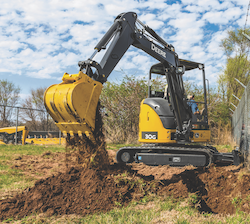 |
|
John Deere mini excavators have a mechanical quick-coupler as standard equipment. The wedge-style coupler design is wear-compensating, improving the life of the coupler and the fit-up of attachments such as buckets, hammers and augers |
 |
|
Kato battery-powered excavators have made a mark in the world of interior demolition and as a work-around to job site emissions regulations. Their small frames, quiet operation and green power are attractive to many DIY customers doing small residential products. |
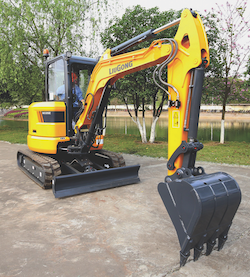 |
|
Rental centers will find even greater success with mini excavators if they offer access to attachments and operator training. |
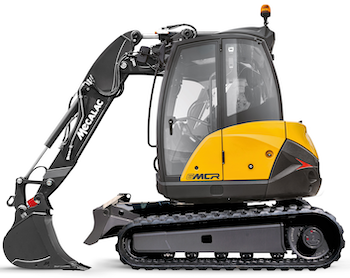 |
|
The patented Mecalac boom system can retract fully, making the machine compact at the front and rear,while decreasing the height clearances above the machine. |
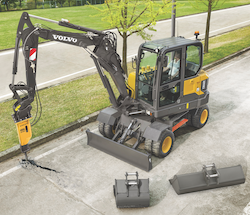 |
| The Volvo EW60E compact wheeled excavator swings 360 degrees and has a top travel speed of 19 mph. |
Telematics, flexible power settings increasingly popular
The industry is quickly shifting toward technology and the ability to monitor and change settings on the machine through integrated, user friendly displays. Hydraulic flows can be adjusted and stored easily for different attachments such as a plate compactor, hammer, or thumb. Telematics is also becoming more useful to monitor idle time and maintenance intervals.
 |
|
ED BRENTON |
For a rental center, it’s critical it has access to telematics data and notifications when machines are operating outside of normal operating parameters. Before telematics, an operator may just keep operating the machine because he or she didn’t understand a code and make the problem worse before parking the machine at the end of the day or bringing it back to the renter/owner.
Rental centers can maximize their ROI opportunity by having machines of varying size classes to capture several different applications and customer bases vs. carrying only one machine size. Some customers will need a more powerful machine with longer dig depth and possibly auxiliary hydraulics to run a hammer or thumb, while a do-it-yourselfer just needs to dig a hole or trench.
Total cost of ownership has to play into the rental rate calculation as well as the return on investment. It is much more so than just the purchase price of the machine. If one brand has an advantage – and it may be something as simple as Brand A’s oil change interval is 500 hours, and Brand B’s is 2,000 hours – if that cost is extrapolated over the duration of ownership, it adds up. For rental centers, all of those costs have to roll up into a profitable rental rate.
It’s important for a rental center to offer machines with the right hydraulics and/or attachments that meet customer needs. It’s not feasible to carry every attachment on the market, so it’s important to know the ongoing needs and projects around your area. Know your customers, your competitors and your suppliers. Becoming a true partner with your equipment supplier will only strengthen your brand.
Early adopters taking on electric units to rent
According to the International Energy Agency (IEA), the global electric vehicle (EV) fleet exceeded 5.1 million vehicles in 2018, a more than 40 percent increase from the two million vehicles in 2017. The IEA is projecting that by 2025, global EV sales could top 100 million per year. These are staggering numbers for an industry where the first electric vehicle was produced in the 1830s.
 |
|
BOB MAGUIRE |
So, it comes as no surprise that when you look at the construction industry, you are starting to see battery-powered mini excavators. At ConExpo 2020, battery-powered mini excavators were all the rage as Europe starts to move toward battery power.
Walk into any rental store and you will see battery-powered tools and forklifts; it is only natural that increasingly, rental centers will begin to offer more battery-powered machines. As batteries become more powerful and less costly, the speed of adoption will increase.
Combustion engines dominate the marketplace because most heavy equipment is used in remote areas for heavy infrastructure, industrial and commercial construction because cheap fuel is easily accessible. As the climate continues to change and cities become more dense, new government regulations are forcing manufacturers to comply with cleaner air requirements.
There are two challenges facing the electrification of construction equipment:
First, buying a piece of construction equipment is not like buying a car. A piece of construction equipment is purchased for the purpose of a return
on investment, and the faster that return comes, the easier it is to make the decision on that purchase.
With electric equipment, the return comes later, but it is also higher as there are up to 90 percent reductions in service and fuel costs over the lifetime of the machine.
Because combustion engines and fuel to power them are still relatively inexpensive to produce compared with electric engines, the low upfront cost and high long-term service costs are still a barrier to entry for some users vs. the high upfront costs and low long-term service costs for electric construction equipment.
The other challenge to the electrification of construction equipment is the ease of access to high-amperage power and charging times. Most construction hand tools can be entirely battery-powered at this point.
The battery technology is advanced enough to power a small power tool efficiently for short periods of time and the time it takes to recharge those batteries is short enough on a standard electrical outlet that it is no longer a barrier to entry to purchase. For heavy equipment such as an excavator or bulldozer, it would simply take too long to recharge a battery that is large enough to power these machines on a standard electrical outlet. Access to a significant power source for several hours is necessary to recharge these massive batteries. In some remote locations where these units work, that is not always available.
Cratos Equipment has been selling battery-powered skid steers for six years. The Sherpa can run for eight continuous hours, which allows contractors to get a full day’s work on one charge.
Now, mini excavators are entering the market. While weighing 3,000 pounds, they also can run for up to eight hours for a full day’s work. As batteries get better and come down in cost, more machines will move toward Li-ion batteries.
What does the future hold for battery-powered equipment? Consider the cell phone camera. In a very short period, it has all but removed the hand-held digital camera from existence. Battery technology will eventually overtake combustion engines as the go-to power source for construction equipment. The question for the rental stores will be who wants to be on board as technology continues to improve as opposed to playing catch up. With more rental stores investing in battery-powered equipment, the time to catch up may be sooner rather than later.
Electric machines offer low operating costs
Clean technology and the reduction of harmful emissions are among the top innovations in this segment and the JCB19C-1E is the first JCB E-Tech machine offered in North America.
 |
|
MATT HODGES |
The 2-ton 19C-1E is ideally suited to excavation applications within enclosed or urban job sites or noise- and emissions-sensitive environments such as hospitals and schools. JCB research indicates that charging costs for the 19C-1E will be 50 percent lower than fuel costs for a comparable diesel-powered machine over a five-year ownership period.
Rental centers can maximize ROI by stocking low-cost machines that meet demand for various niche markets that are willing to pay a higher rental price due to its unique features. Mini excavators like the JCB 19C-1E are ideal for this as there are many customers willing to pay a premium rental rate for a machine that meets noise and emission standards for indoor and intercity job sites. Their return is not only maximized by higher rental rates, but with fewer consumable spare parts and fluids and servicing costs will be up to 70 percent lower, reducing the rental center’s investment cost.
Mini excavators are much more than just diggers. With the use of attachments such as augers, breakers and rock saws, rental centers can increase rates while customers make the most of their rental costs.
Uptime is always at the top of the list of needs for customers and rental centers. Avoiding service time and reducing daily maintenance becomes crucial to achieving this goal of keeping the machine working at peak performance.
JCB helps achieve this in many ways by focusing on quality components and engineering, clean technology in the 19C-1E, and the use of telematics.
JCB LiveLink is a telematics platform that makes life easier and is the fastest way to confirm that the machines are well maintained and in good health without physically inspecting machines.
Telematics and attachments boost rentability
We see increasing demand among rental organizations for mini excavators that are versatile, reliable and compatible with new technology such as telematics. While auxiliary hydraulic lines have been standard equipment on John Deere mini excavators, within the last year, engineers have added a selector valve on the arm of all 26G through 85G models that allow users to plumb two attachments simultaneously. The operator can switch the auxiliary flow between each of the attachments by simply rotating a knob on the valve.
 |
|
JONNY SPENDLOVE |
All Deere mini excavators have a mechanical quick-coupler as standard equipment. The wedge-style design of the coupler is wear-compensating, improving the life of the coupler and the fit-up of attachments from buckets to hammers to augers.
While we see a trend toward larger mini excavators, customers still want machines that are easy to get on and off the job site quickly. All Deere mini excavators have large and conveniently placed tie-downs that make trailering simpler.
Rental centers can increase mini excavator demand by configuring them to meet the needs of the market. Model size, transportability, arm length and track type will affect customer demand. Understanding the requirements of the customer base and then assemble a rental fleet based upon those needs will return the highest yield.
While Deere mini excavators are among the most reliable and durable machines in Deere’s product portfolio, following regular maintenance will help rental centers get ahead of potential downtime issues and major repairs. Using the recommended engine oils, filters, grease, and coolants – and adhering to the service intervals – is key to getting the most out of your mini excavator. Using simple telematics systems to understand how and where machines are being used will also improve machine ROI.
Battery power takes excavators inside
One of the biggest industry shifts has been the emergence and growing popularity of battery-powered excavators. As the technology has proven itself as a comparable machine to their diesel-powered counterparts, their application has exploded.
 |
|
BART DEHAVEN |
The Kato 9VXB and 17VXB excavators have made a mark in interior demolition and provide a work-around to job site emissions regulations. Their small frames, quiet operation and green power are attractive to many DIY customers doing small residential jobs.
One of the added benefits of battery power is the ability to offset other costs on a job. Work in healthcare and food service facilities can be completed without extensive ventilation or sanitizing.
Rental centers that maintain a line of quality and user-friendly machines are an attractive rental option for contractors and DIYers. Maintaining equipment to minimize downtime is the most important thing a rental center can do to improve ROI. Beyond the sticker price of adding a machine to your fleet, how accessible are parts and service experts? Are manufacturer reps available when you need them?
Get to know manufacturers and work with companies that see you as a partner, not just a customer. A company with programs like a strong parts distribution network, knowledgeable and accessible service experts, marketing staff who can assist with advertising and build awareness can help mitigate down time and keep your machine rented.
The moving target of emissions regulations is a major hurdle for manufacturers, rental operators and contractors. However, maintaining a versatile fleet is the best way to mitigate this issue. Diversifying the size and power source of the excavator fleet will give a rental center the ability to make competitive bids for almost any job.
Look for features that add versatility
Many Kubota models are equipped with industry-leading features that are designed to be intuitive and user-friendly, making them accessible even to the rental user who might not be on the machine every day. Examples of these features include:
|
PATRICK BAKER |
Economy mode: Kubota KX040-4, U55-4, and KX057-4 models have an ECO mode that allows for increased fuel savings without sacrificing digging performance.
Auto idle: This feature idles the engine if the controls are not moved for four seconds and automatically returns the unit to operating speed when the operator touches a control, saving fuel, emissions and noise pollution on the job site.
Auxiliary diverter valve: Standard on most Kubota models, it provides the ability to have a thumb attachment connected while running other hydraulic attachments.
The number of attachments for excavators continues to grow because of the time-saving efficiency they offer for a wide range of applications. Tilt-angle buckets, thumbs, breakers and mowers are a few examples of what operators use on compact excavators to make efficient use of time. Kubota excavators allow the operator to adjust the hydraulic flow from the cab. Matching the flow to the attachment prevents damage and makes the best use of the attachment.
Rental equipment can take a beating from rental customers, so a strong rental-center focus on a maintenance and service is key to success. Kubota has made routine maintenance simple by consolidating primary engine components onto one side of the machine for easier access. From this point, engine and other vital components can be inspected quickly and serviced safely to ensure excellent performance.
Rental centers will come across customers with varying skill levels that run different control patterns. All Kubota compact excavators come with the a two-pattern selection system (TPSS). The TPSS is positioned under the seat and allows the rental center to set the operator control style with the simple flip of a switch, putting the customer at ease about the operation.
Total cost of ownership drives selection
Customers are looking for a machine with low transport costs. Electric mini-excavators can be transported economically and fill the need for zero-emission machines for indoor use or where government regulation or corporate standards are requiring them.
 |
|
GITA RAO |
Rental centers and end users want lowest total cost of ownership (TCO); making it easier to service a machine is one way to do that. Machine reliability and maintenance cost are big part of TCO as well.
Reducing TCO will include increasing reliance on telematics. It’s quickly becoming a standard feature on rental excavators. It can help keep operating cost and downtime to a minimum and helps with billing, theft prevention, equipment location, reporting and recordkeeping.
Rental centers can make their mini excavator fleet more appealing to customers with units that are easier to maintain and have extended lubrication intervals. Attachments, such as thumbs or pin-grabbing couplers can make the units versatile and rentable, especially if the excavator is outfitted with auxiliary hydraulic lines. Renters appreciate cabs that offer in-cab storage and ample leg room as well as easy-to-understand and simple-to-use controls. Rental centers will find even greater success with mini excavators if they offer access to attachments and operator training, then provide service help when it’s needed.
Redefining mini excavators
With workspaces growing ever tighter and access becoming more restricted, the machines used for those jobs must change. Excavator manufacturers have worked to reduce the size of their machines, in particular their tail swing radius, but this has often been done at the expense of stability, lifting capacity and space for the operator.
|
VERONIQUE KENNERSON |
Mecalac recognized the need for urban excavators that combine compactness with performance. Compactness is not only a matter of reducing the rear radius. Mono-boom and dipper configurations make the machine front-heavy and get in the way when rotating, so the rear zero-swing radius doesn’t mean much.
For Mecalac, compact means 360 degrees. The patented Mecalac boom system can retract fully, making the machine compact at the front and rear, while decreasing the height clearances above the machine as well.
Reducing fuel consumption and cost of operation, is important, so Mecalac machines come standard with automatic low idle or engine idle shutdown and other ways to reduce fuel consumption.
Mecalac engineers also see a trend in adding tools that are more versatile, such as tilt-rotators or tilting devices.
Speed on the job site is important. The Mecalac skid excavator can go 6.2 mph, which is twice as fast as any other compact excavator. It also has a 0.7 cubic-yard bucket that is 77 percent larger than the buckets used on this size-class and all this with the total swing diameter of a 2-ton excavator.
When this much work takes place on design, new possibilities appear. Mecalac’s unique boom kinematics allow unprecedented movement flexibility. It has the ability to excavate and push material so the excavator can also be used as a compact track loader. Jobs can be completed much faster with only one machine and one operator.
Choosing equipment for the rental business often boils down to finding an inexpensive, easy-to-use machine with the most basic configuration, but this segment is more complex than that.
Almost all mini excavators look the same and have a similar price. It’s time to consider another approach. Whenever a contractor wants to reduce costs, a global approach is more effective. Consider not only the machine, but the whole job site. If the demand is for an excavator and a skid steer loader, think about Mecalac units. Because with one machine instead of two; one operator instead of two; service and spare parts for only one machine instead of two; costs plummet.
Loader buckets can be used, in reverse, just like any compact loader attachment. The ISO24410 universal skid steer adapter will even let users mount skid-steer attachments directly on the machine.
The basic purchase price may be a bit higher, but the increase of productivity will drastically increase the return on investment, while operating costs will be reduced.
Sometimes a rental is more than just a rental. It’s a new way of looking at things and differentiating oneself from the competition.
Telematics leverages availability
Telematics is becoming popular with many manufacturers today. The ability to manage assets remotely and see how the machine is being utilized, where it is located, and its health/condition can be a big benefit to rental companies that want to minimize downtime and maintain asset security.
 |
|
DAVID CALDWELL |
A good telematics system such as Takeuchi Fleet Management (TFM) enables a fleet manager to plan ahead and schedule maintenance and repairs in a very proactive and efficient manner. This approach to service and maintenance saves the customer and rental company time, resulting in greater profits and productivity.
It is important that the rental center ensures that the customer has the right size machine for the job. Consider the dig depth, lifting capability, bucket size or type of attachment or tool needed to complete the job. By asking the customer these questions, the rental center can ensure the customer has the right excavator for the job.
Wheeled mini excavators offer advantages
Compact excavators are continually becoming more versatile. For example, when working in tight spaces, it’s cumbersome to maneuver a backhoe that only has a 180-degree working radius compared to 360 degrees on a compact track excavator or the EW60E compact wheeled excavator, that also swings 360 degrees and a top travel speed of 19 mph.
|
JOHN COMRIE |
Rental centers can be successful in renting these units by emphasizing their versatility, including the capability to use a wide array of attachments.
When purchasing, size and equipping the machines with the correct features for a variety of attachments can improve availability and rentability.
Wear and tear on the undercarriage is a huge part of owning and operating costs, so make sure machine is equipped with the right tracks for your region.
Over the last few years, compact excavators have improved in performance and can often replace a bigger excavator. Compact excavators have a lower investment cost, lower running cost and are easier to transport. Doing some research on what’s available today may mean huge savings tomorrow.
Get creative in your selection process. Wheeled compact excavators offer drivability from site to site and require less cleanup because they do less damage to ground surfaces. Features like twin wheels, locking axles and dozer blades help maintain the stability without sacrificing power, breakout/tearout forces, reach or digging depth.
For rental centers, the more versatile a machine is, the more often it can be rented and the more valuable it is. Attachments make all the difference. Customers want one-stop shopping and attachments can help achieve that. It’s critical to have a good selection of attachments on hand and ready to go that are clean and have no leaks.
Give the customer some basic training on the attachment. What is normal for you may not be normal to the customer, and they will appreciate that you took the time to go over the dos and don’ts.
If the customer can get on with job and make some money, there’s a good chance they’ll give you first shot the next time they need to rent a compact excavator.
New models offer new capabilities
The evolution of telematics on compact equipment – including compact excavators – provides great value for rental centers. The technology gives them greater visibility to what is going on with their machines. It assists with maintenance and can help locate where those machines are at all times.
 |
|
JASON BOERGER |
Bobcat recently launched the R2-Series E42 and E50 compact excavators that have been designed to deliver enhanced performance, control and efficiency for operators. Improved low-effort joysticks enable longer operation with less fatigue. They provide quick and precise movement with low effort, while the new hydraulic control valve offers improved metering, finite movement and controllability for level grading as well as fast cycle times.
The dual-flange track rollers on the R2-Series excavators extend the undercarriage structure closer to the track’s edge, which helps increase lift-over-side capacity and improves over-the-side digging performance and slewing ability.
A redesigned engine delivers the performance operators need while reducing and simplifying routine maintenance. Plus, it provides lower noise levels so operators can enjoy a quieter environment.
An optional clamp diverter valve has been added for enhanced hydraulic clamp functionality and improved ability to run other attachments without disconnecting the clamp. Auxiliary hydraulics are easier to reach and attach, thanks to a new location on the excavator arm. A standard integrated lift eye provides a convenient method for handling objects or moving them in and out of the trench. An optional touch display presents detailed machine information and unprecedented device connectivity, and an optional rear camera offers a continuous rear view from the operator’s seat when desired.
Compact excavators in the 3-ton size class have been popular with rental centers and that trend will continue. They have continued to grow in popularity because they are compact, powerful and can fit in confined spaces. Bobcat compact excavators offer multiple arm types and tail swing configurations. Their in-track swing frame allows customers to get closer to the work.
Machine versatility continues to improve with the variety of attachments that can be used on compact excavators.
Buckets continue to be very popular, but other attachments like flail mowers, augers, clamps, breakers and plate compactors make compact excavators help customers be more efficient on their job sites. This also helps rental centers increase machine utilization because of the multiple jobs that can be accomplished with one machine and a few attachments.
One of the most common needs rental customers face is fuel availability. Fuel can be one of the most expensive operational expenses and is an important consideration to note especially if the rental customer will be using the machine for an extended period. As a rental center, it’s important to understand how today’s diesel fuel is different and how it relates to advanced engines. Educating the customer on using clean fuel is the first line of defense in keeping the machine running in top performance.
Encourage rental customers to purchase the cleanest fuel possible. Purchase fuel from a trusted supplier and confirm the fuel’s cloud point, which is dependent on geographic location and time of year.
Bulk fuel stored in the renter’s yard should be tested every six months and the supply tank fuel filters should be clean, 2-micron fuel filters.
-30-
This article originally appeared in the September-October 2020 issue of Pro Contractor Rentals magazine. © 2020 Urbain Communications LLC.










